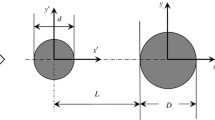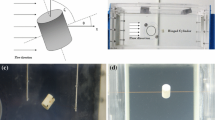Abstract
The dominant vortex frequencies f s in the wake of two tandem circular cylinders of identical diameter d have been measured simultaneously using two hot wires placed behind each cylinder. Measurements were conducted over the Reynolds number Re (≡U ∞ d/ν, where U ∞ and ν are the free-stream velocity and the kinematic viscosity of fluid, respectively) =800–4.2×104 and the cylinder centre-to-centre spacing L/d=1–15. The Strouhal number St (≡f s d/U ∞) exhibits a strong dependence on L/d and Re. For L/d<(L/d)c, which is a critical value and ranges between 3.5 and 5, there is no vortex street formed in the gap between the cylinders, and St measured behind the downstream cylinder drops rapidly for increasing L/d. For L/d>(L/d)c, co-shedding occurs, that is, vortices are shed from the upstream as well as the downstream cylinder, and their frequencies are found to be identical. St climbs with increasing L/d, approaching a constant between 0.18 and 0.22 for L/d>10. The St–Re relationship is classified into four categories, based on their behaviours, which are associated with distinct flow physics—category 1: for 1≤L/d<2, the shear layers separated from the upstream cylinder roll up behind the downstream cylinder; category 2: for 2≤L/d≤3, there is a transition from the shear layer rollup behind to reattachment on the downstream cylinder; category 3: for 3<L/d≤5, transition from the reattachment to co-shedding regime occurs at a critical Reynolds number; and category 4: the flow for L/d>5 is characterized by co-shedding only. The present measurements reconfirm the previous observation of a bi-stable flow at the transition from the reattachment to co-shedding regime. It is found for the first time that another bi-stable flow occurs at the transition from category 1 to 2, that is, the stable reattachment co-exists with the stable rollup (behind the downstream cylinder) of shear layers separating from the upstream cylinder, resulting in two distinct vortex-shedding frequencies even at the same Re and L/d. The St behaviour is further discussed along with flow visualization using the laser-induced fluorescence technique.










Similar content being viewed by others
References
Arie M, Kiya M, Moriya M, Mori H (1983) Pressure fluctuations on the surface at two circular cylinders in tandem arrangement. J Fluid Eng 105:161–167
Armstrong BJ, Barnes FH, Grant I (1987) A comparison of the structure of the wake behind a circular cylinder in a steady flow with that in a perturbed flow. Phys Fluids 30:19–26
Bauer AB (1961) Vortex shedding from thin flat plates parallel to the free stream. J Aeronaut Sci 28:340–341
Bearman PW (1984) Vortex shedding from oscillating bluff bodies. Ann Rev Fluid Mech 16:195–222
Bloor MS (1964) The transition to turbulence in the wake of a circular cylinder. J Fluid Mech 19:290–304
Bloor MS, Gerrard JH (1966) Measurements on turbulent vortices in a circular cylinder. Proc R Soc A 294:319–342
Chang K, Song C (1990) Interactive vortex shedding from a pair of circular cylinders in a transverse arrangement. Int J Num Meth Fluids 11:317–329
Gerrard JH (1966) The mechanics of the formation region of vortices behind bluff bodies. J Fluid Mech 25:401–413
Hori E (1959) Experiments on flow around a pair of parallel circular cylinders. In: Proceedings of the 9th Japan National Congress for Applied Mechanics, Tokyo, pp 231–234
Huhe-Aode H, Tatsuno M, Taneda S (1985) Visual studies of wake structure behind two cylinders in tandem arrangement. Rep Res Inst Appl Mech Kyushu Univ 32(99):1–20
Igarashi T (1981) Characteristics of the flow around two circular cylinders arranged in tandem, 1st report. Bull JSME B24(188):323–331
Igarashi T (1984) Characteristics of the flow around two circular cylinders arranged in tandem, 2nd report. Bull JSME B27(233):2380–2387
Ishigai S, Nishikawa E, Nishimura K, Cho K (1972) Experimental study on structure of gas flow in tube banks with tube axes normal to flow (Part 1, Karman vortex flow around two tubes at various spacings). Bull JSME 5(86):949–956
Jester W, Kallinderis Y (2003) Numerical study of incompressible flow about fixed cylinder pairs. J Fluids Struct 17:561–577
Lai WC, Zhou Y, So RMC, Wang T (2003) Interference between stationary and vibrating cylinder wakes. Phys Fluids 15:1687–1695
Lin J-C, Yang Y, Rockwell D (2002) Flow past two cylinders in tandem: instantaneous and averaged flow structure. J Fluids Struct 16:1059–1071
Liu C-H, Chen JM (2002) Observations of hysteresis in flow around two square cylinders in a tandem arrangement. J Wind Eng Ind Aerodyn 90:1019–1050
Ljungkrona L, Norberg C, Sunden B (1991) Free-stream turbulence and tube spacing effects on surface pressure fluctuations for two tubes in an in-line arrangement. J Fluids Struct 5:701–727
Mittal S, Kumar V, Raghuvanshi A (1997) Unsteady incompressible flows past two cylinders in tandem and staggered arrangements. Int J Num Meth Fluids 25:1315–1344
Monkewitz P, Nguyen LN (1987) Absolute instability in the near wake of two-dimensional bluff bodies. J Fluids Struct 1:165–184
Moriya M, Sakamoto H (1986) Effect of a vibrating upstream cylinder on a stationary downstream cylinder. J Fluids Eng 108:180–184
Norberg C (1994) An experimental investigation of the flow around a circular cylinder: influence of aspect ratio. J Fluid Mech 258:287–316
Norberg C (1998) LDV-measurements in the near wake of a circular cylinder. In: Williamson CHK, Bearman PW (eds) Advances in understanding of bluff body wakes and flow-induced vibration (FEDSM98–5202). ASME, New York, pp 1–12
Novak J (1974) Strouhal number of a square prism, angle iron and two circular cylinders arranged in tandem (in English). Acta Tech Czech Acad Sci 3:361–373
Ohya Y, Okajima A, Hayashi M (1989) Wake interference and vortex shedding. In: Cheremisinoff NP (ed) Encyclopedia of Fluid Mechanics. Gulf, Houston, pp 323–389
Oka S, Kostic ZG, Sikmanovic S (1972) Investigation of the heat transfer processes in tube banks in cross flow. In: International Seminar on Recent developments in heat exchangers, Trogir, Yugoslavia (preprint)
Okajima A (1979) Flows around two tandem circular cylinders at very high Reynolds numbers. Bull JSME 22:504–511
Prasad A, Williamson CHK (1997) The instability of the shear layer separating from a bluff body. J Fluid Mech 333:375–402
Roshko A (1955) On the wake and drag of bluff bodies. J Aeronaut Sci 22:124–132
Sakamoto H, Haniu H (1988) Aerodynamic forces acting on two square prisms placed vertically in a turbulent boundary layer. J Wind Eng Ind Aerodyn 31:41–66.
Schlichting H (1979) Boundary-layer theory. McGraw-Hill, New York, p 32
Slaouti A, Stansby PK (1992) Flow around two circular cylinders by the random-vortex method. J Fluids Struct 6:641–670
So RMC, Zhou Y, Liu MH (2000) Free vibrations of an elastic cylinder in a cross flow and their effects on the near wake. Exp Fluids 29:130–144
Tanida Y, Okajima A, Watanabe Y (1973) Stability of a circular cylinder oscillating in uniform flow or in a wake. J Fluid Mech 61:769–784
Williamson CHK, Brown GL (1998) A series in 1/Re 1/2 to represent the Strouhal–Reynolds number relationship of the cylinder wake. J Fluids Struct 12:1073–1085
Wu J, Welch LW, Welsh MC, Sheridan J, Walker GJ (1994) Spanwise wake structures of a circular cylinder and two circular cylinders in tandem. Exp Thermal Fluid Sci 9:299–308
Xu SJ, Zhou Y, So RMC (2002) Flow structure behind a streamwise oscillating cylinder. In: Proceedings of the Conference on Bluff body wakes and vortex-induced vibrations, 17–20 December 2002, Fort Douglas, Queensland, Australia, pp 183–186
Zdravkovich MM (1977) Review of flow interference between two circular cylinders in various arrangements. J Fluids Eng 99:618–631
Zdravkovich MM (1985) Flow induced oscillations of two interfering circular cylinders. J Sound Vibrat 101:511–521
Zdravkovich, M.M. 1987 The effects of interference between circular cylinders in cross flow. J Fluids Struct 1:239–261
Zhou Y, Wang ZJ, So RMC, Xu SJ, Jin W (2001) Free vibrations of two side-by-side cylinders in a cross flow. J Fluid Mech 443:197–229
Zhou Y, Zhang HJ, Yiu MW (2002) The turbulent wake of two side-by-side circular cylinders. J Fluid Mech 458:303–332
Acknowledgements
The authors wish to acknowledge support given to them by the Central Research Grant of The Hong Kong Polytechnic University through Grant G-YW74.
Author information
Authors and Affiliations
Corresponding author
Rights and permissions
About this article
Cite this article
Xu, G., Zhou, Y. Strouhal numbers in the wake of two inline cylinders. Exp Fluids 37, 248–256 (2004). https://doi.org/10.1007/s00348-004-0808-0
Received:
Accepted:
Published:
Issue Date:
DOI: https://doi.org/10.1007/s00348-004-0808-0




